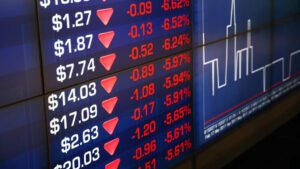
The meeting of shareholders of the tobacco company “JTI Ukraine” (JT International Company Ukraine, Kyiv) decided to satisfy the application for resignation from the post after September 30 of its current CEO Paul Holloway, instead of him Svetlana will be appointed for two years Sharamok.
The shareholders made the corresponding decision on September 20, follows from the company’s message on the information disclosure system of the National Central Design Bureau of Financial Markets.
It is specified that Holloway took office as CEO of JTI Ukraine on January 1, 2018 and will leave it on September 30. In turn, Sharamok was accepted to the specified position for a period of two years – from October 1, 2022 to October 1, 2024.
According to JTI, from April 2021 to September 2022, Sharamok worked as the marketing director of JT International Company Ukraine, and she also held the position of country manager for the Caribbean region at JTI Corporation.
“JTI Company Ukraine” is part of the international group of companies Japan Tabacco Inc. (JTI). In Ukraine, she owns the Kremenchug tobacco factory (Poltava region).
The most famous brands of “JT International Ukraine” are Sobranie, Winston, Camel, Glamor and LD.
Products are sold in Ukraine and were exported to 22 countries before the war.

European producers, faced with a surge in energy prices, are shifting operations to the United States, hoping to take advantage of both greater stability in the US energy market and government incentives, The Wall Street Journal writes.
Experts warn of the possibility of a new wave of deindustrialization in Europe amid wild energy price fluctuations and persistent problems in supply chains. The operating environment in the US looks much more favorable, especially for chemical manufacturers and companies in other energy-intensive industries. In August, US President Joe Biden signed the Inflation Reduction Act (IRA), which provides, in particular, tax incentives for industrial companies and representatives of the green energy sector.
Earlier this month, the WSJ reported, citing sources, that American electric car maker Tesla Inc. paused a plan to manufacture batteries in Germany in connection with the possibility of obtaining tax benefits in the United States. Sources told the paper that Tesla is considering shipping battery manufacturing equipment to the States for its Berlin facility.
European companies that have announced expansions in the US this year include automaker Volkswagen AG, as well as, for example, the Dutch chemical company OCI NV, which owns an ammonia plant in Texas.
European steelmaker ArcelorMittal SA earlier this month announced it was cutting production at two plants in Germany. At the same time, the results of her Texas enterprise turned out to be better than expected, which the head of the company, Aditya Mittal, explained by the low cost of energy in the region.
Experts note that the US economy has weathered the pandemic fairly well and is more attractive for business than Europe and China, despite record inflation, continued problems in supply chains and the risks of a recession as a result of tightening monetary policy by the Federal Reserve System (Fed). China is still under lockdown to contain the spread of COVID-19, and Europe is destabilized by the energy crisis due to the conflict in Ukraine.
It will be difficult for European manufacturers to remain competitive without lower energy prices or government subsidies, said Svein Tore Holseter, chief executive officer of Norwegian chemical company Yara International ASA.
“Some industries will have to relocate production on a permanent basis as a result,” he said.

Net sales of dollars by the National Bank of Ukraine rose to $737.8 million last week compared to $510.7 million a week earlier and $475.0 million two weeks earlier.
According to the information of the National Bank on its website, from September 19 to 23, it purchased $7.1 million, which corresponds to the usual purchase volumes during the war, while it sold $744.9 million compared to $528.2 million a week earlier.
This week, on the cash market, the hryvnia again weakened by about 70 kopecks, and its rate came close to the level of UAH 43/$1, while the official rate of UAH 36.57/$1 was fixed since July 21, but by the end of the week it strengthened to UAH 42.7/$1. $1.
Since the beginning of September, the volume of interventions of the National Bank in the market has already exceeded $1.8 billion compared to $1.33 billion in August and $1.2 billion in July, but still remains much less than in June ($3.96 billion) and May ( $3.4 billion).
Finance Minister Sergei Marchenko said that in August the volume of foreign aid to Ukraine amounted to a record $4.6 billion since the beginning of the war, compared with $1.7 billion in July and $4.4 billion in June.
In general, from the beginning of the year to September 23 inclusive, the NBU purchased $3 billion 121.3 million and EUR111.0 million on the market, and sold $18 billion 607.7 million and EUR1 billion 789.1 million.
Including since the beginning of the war, the purchase of foreign currency has reached $2 billion 464.4 million and EUR111.0 million, and the sale – $15 billion 837.5 million and EUR1 billion 789.1 million.
The international reserves of Ukraine as of September 1, 2022, according to the NBU, amounted to $25.436 billion (in equivalent), which is 13.6% or $2.679 billion more than at the beginning of August. In July, the fall in reserves amounted to 1.6%, or $371.5 million, in June – 9.3%, or $2 billion 343.8 million.

20 heavily wounded Ukrainian servicemen will undergo treatment in Israel, the Israeli Embassy in Ukraine reported on Twitter on Sunday.
“Israel will accept for treatment 20 Ukrainian servicemen who were seriously injured during the hostilities,” said Israeli Ambassador to Ukraine Mikhail Brodsky.
According to him, the transportation of the wounded was organized by the Israeli Embassy, the Israeli Mashav Center and the Israeli Ministry of Health in cooperation with the Ministry of Health of Ukraine.

The pound sterling fell sharply against the US dollar during morning trading on Monday and hit a historic low on signals from the British Treasury about the likelihood of new tax breaks in addition to those announced last week.
The pound by 8:50 Moscow time fell by 2.6% and is $1.0570 compared to $1.0850 at the close of the previous session. Earlier in the day, the rate fell to $1.0327, which is the lowest level since 1971, when the UK switched to a decimal currency system.
Last week, UK Treasury Secretary Quasi Kwarteng announced a massive tax cut that will affect individuals and businesses and increase the budget deficit for the current fiscal year by more than 70 billion pounds.
“This government has only been in office for 19 days,” Kwarteng told the BBC on Sunday. “In the coming year, I would like to see people keep even more of their income because I believe the people of the UK will be the engine of the country’s economy.”
The market regarded this as a hint of new tax incentives, writes Bloomberg.
The ICE-calculated index, which shows the performance of the US dollar against six currencies (the euro, the Swiss franc, the yen, the Canadian dollar, the pound sterling and the Swedish krona), rose by 0.75%, exceeding 114 points for the first time since May 2020, according to Trading Economics .
The dollar is supported by the demand for defensive assets caused by fears of a global recession. In addition, currency traders point out that the Fed is tightening monetary policy at a faster pace than the rest of the world’s leading central banks.Pair pound / dollar has updated a historical low
The euro/dollar pair is trading at $0.9636 compared to $0.9690 at the close of the session last Friday, the euro loses about 0.6% and again updates the lows in two decades.
The rate of the American currency against the yen increases by 0.4% and amounts to 143.87 yen compared to 143.34 yen last Friday.

Pressure on Asian markets is exerted by growing fears that the rapid tightening of monetary policy by the world’s largest central banks, trying to contain inflation, will provoke a recession in the global economy.
“The downward momentum we saw on Wall Street late last week has spilled over into Asia,” said Jun Rong Ying, an analyst at IG in Singapore, quoted by Market Watch.
The strengthening of the US dollar also has a negative impact on Asian stock markets, the expert says.
Japan’s Nikkei 225 lost 2.6% in trading on Monday.
The Purchasing Managers Index (PMI) in the industrial sector of Japan, calculated by Jibun Bank, fell in September to the lowest since January 2021 51 points compared to 51.5 points in August, according to preliminary data.
At the same time, the services PMI rose to a three-month high of 51.9 from 49.5 in August, while the composite PMI rose to its highest since June of 50.9 (49.4 in August).
The decline leaders among the components of the Nikkei 225 are shares of SoftBank Group Corp. (-5.4%), Mitsubishi UFJ Financial (-4.9%), Honda Motor (-5%), Sony Group Corp. (-4.3%), Toyota Motor (-3%).
Chinese indexes Shanghai Composite and Shenzhen Composite lost 0.1% and 0.7% respectively.
Last week, experts from Nomura and Goldman Sachs downgraded their forecasts for the Chinese economy for 2023 due to the tough policy of the Chinese authorities in containing the spread of COVID-19. This week, China’s National Bureau of Statistics is to release its September PMI, which is expected to give an indication of how fast the Chinese economy is recovering.
Shares of Zijin Mining Group lost 6.8% in trading on Monday, PetroChina – 3.7%, China Coal – 3.2%. At the same time, alcohol maker Kweichow Moutai rose 2.5% and Great Wall Motor rose 1.4%.
The Hong Kong Hang Seng is losing 0.4%. CNOOC shares fell 4.2%, CITIC – 5.7%, Meituan – rose 4.9%, Tencent – jumped in price by 4.3%.
From Monday, Hong Kong will end the quarantine for arrivals in the country, introduced for the first time 2.5 years ago.
The Australian stock index S & P / ASX 200 fell during trading by 1.3%. BHP Group fell 3%, Rio Tinto – 3.4%, Fortescue Metals – 2.8%.
South Korean KOSPI loses 3.8%.